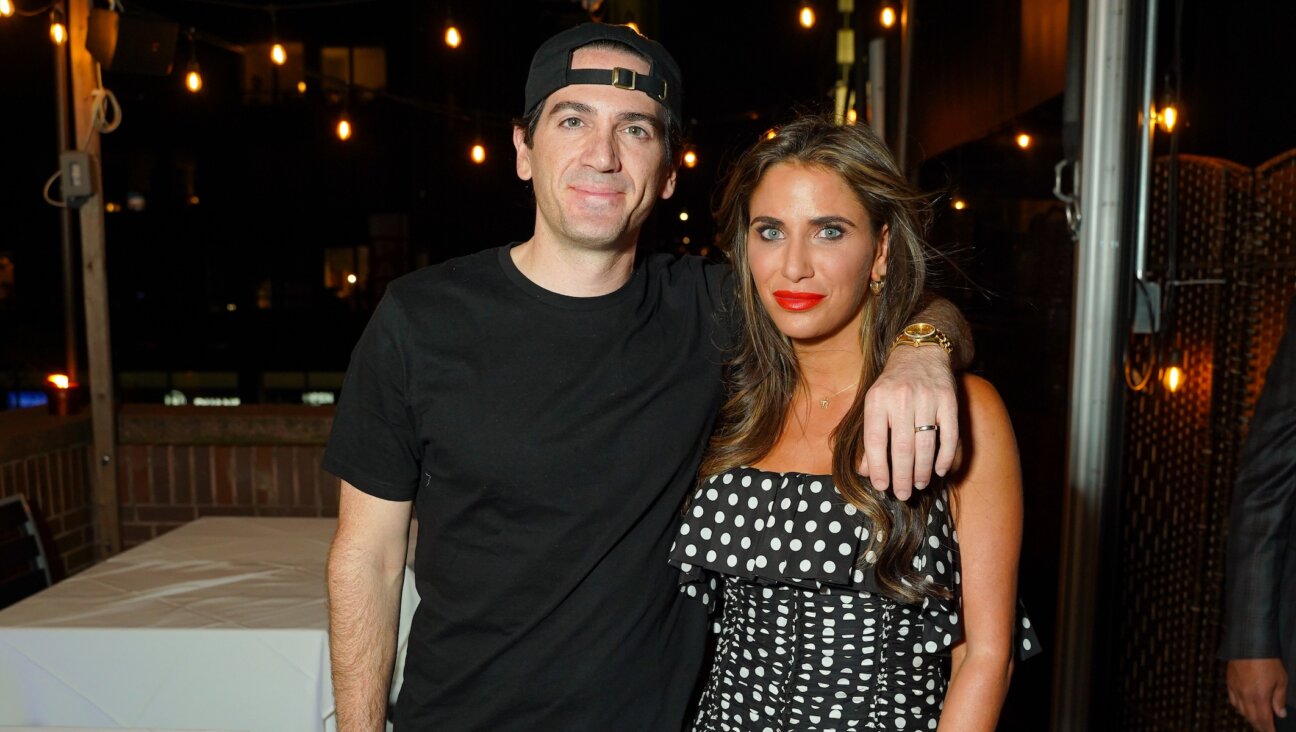10 Jews Whose Style Fiercely Challenges Traditional Masculinity

(From left) Ezra Miller, Timothee Chalamet, Taika Waititi, Ezra Furman Image by Getty/Forward Montage
Socrates, allegedly, always wore the same threadbare himation, consistent with his pursuit of virtue over material items.
Psychoanalyst Jacques Lacan advocated for sartorial peacocking — he believed a person’s selfhood would always be defined by how the person is perceived, so a brilliant presentation was key.
And Shahidha Bari writes that French philosopher Hélène Cixous dreamed of a dress that both reveals and conceals a person’s selfhood. The dress “hides me transparently,” she writes. “And here I am, dressed at the closest point to myself. Almost in myself.”
The way we attire ourselves instructs the world how to perceive us. It’s a tricky business — deep grooves caused by culture, gender, and access constantly shift expectations, and there’s no escape from judgment for the way we look.
Enter women in menswear: Early women who wore pants were literally stoned in the streets. But according to fashion historian Jo Paoletti, women persevered and were rewarded because masculinity has positive associations in a workplace, and in general.
Rarely in modern history has the trend gone the other way — femininity has no such associations. “Feminine clothing has absolutely no social capital for a man,” women and gender studies professor Marjorie Jolles told Racked, “because he’s gesturing towards a set of traits that our society doesn’t really value.”
But with political upheaval comes an opportunity to cast aside traditionally masculine fashion for something more fabulous. Prohibition-era fashion revolted against corsets. Civil rights-era fashion revolted against conformity, welcoming men to dress more typically feminine, a style that retained its casual comfort but lost much of its femininity in the next decade.
Fashion that bends gender expectations or dismisses them entirely has so risen in popularity on runways and on streets that the Museum of Fine Arts in Boston plans to put on the first ever major exhibition on the subject this Spring.
Rolling up on red carpets in scarlet lips and embroidery, consistently, are Jewish men and gender non-binary stars and influencers. We’re not imagining it — just in the short list of celebrities who notably transgress masculinity in their apparel are two men named Ezra.
Perhaps it’s the history of our connection to the shmatteh business, the emphasis on creativity, or just the knowledge that Jewish people are already, on some level, outsiders, even when we enter the inner sanctums of the elite. Like Hélène Cixous, we want to be concealed and revealed. To be dressed in ourselves.
These Jewish influencers push gender presentation past the bounds of traditional masculinity.
1. Ezra Miller

Ezra Miller attending movie premieres in 2018 Image by Getty/Forward Montage
Ezra Miller pushes the envelope, shakes out the contents, and licks the adhesive for good measure. Their embrace of makeup and non-traditional materials lends the look an awesome and awful grandeur.
2. Ezra Furman
Punk rock star Ezra Furman (he just did the music for Netflix’s “Sex Education”) favors a classic: lipstick and pearls.
3. Taika Waititi

Taika Waititi Image by Getty/Forward Montage
Taika Waititi’s talent is so enormous (he has an Oscar nomination, directed “Thor: Ragnarok,” and will soon star in a movie he also wrote and directed, in which he’ll play Adolf Hitler,) that it’s easy to overlook his joyful, girly style. And that would be a pity, because you’d miss all the pineapples.
4. Raviv Ullman
The Israeli-American Ullman’s original claim to fame is his work in the title role on Disney’s “Phil of the Future.” Now Ullman is a style icon who wants to “deconstruct toxic masculinity and tear down the patriarchy.” Sounds like a way better future than what Disney had in mind.
5. Ansel Elgort

Ansel Elgort Image by Getty Images
Oh, Ansel! We never tire of the compellingly insufferable movie star’s penchant for handbags.
6. Troye Sivan

Troye Sivan Image by Getty/Forward Montage
The 23-year-old has the last name of a Hebrew month, a chart-topping gay sex anthem, and the alluring aesthetic of a flower in bloom.
7. Adam Eli
Eli is the founder of the queer liberation activist group Voices4, and credits his Jewish heritage for catalyzing his justice work. And he looks great in heels.
8. Timothée Chalamet

Timothée Chalamet, X four Image by Getty/Forward Montage
A punk Little Lord Fauntleroy, Chalamet favors the flamboyant designs of Haider Ackermann and Alexander McQueen.
9&10. Ovadia & Sons
These days, Israeli twins Ariel and Shimon Ovadia’s designs show up in the pages of Vogue. But their fluffy pink jackets and calf-length leopard print driving coats were originally inspired by their grandfather.
Jenny Singer is the deputy lifestyle editor for the Forward. You can reach her at [email protected] or on Twitter @jeanvaljenny
A message from our Publisher & CEO Rachel Fishman Feddersen

I hope you appreciated this article. Before you go, I’d like to ask you to please support the Forward’s award-winning, nonprofit journalism so that we can be prepared for whatever news 2025 brings.
At a time when other newsrooms are closing or cutting back, the Forward has removed its paywall and invested additional resources to report on the ground from Israel and around the U.S. on the impact of the war, rising antisemitism and polarized discourse.
Readers like you make it all possible. Support our work by becoming a Forward Member and connect with our journalism and your community.
— Rachel Fishman Feddersen, Publisher and CEO























